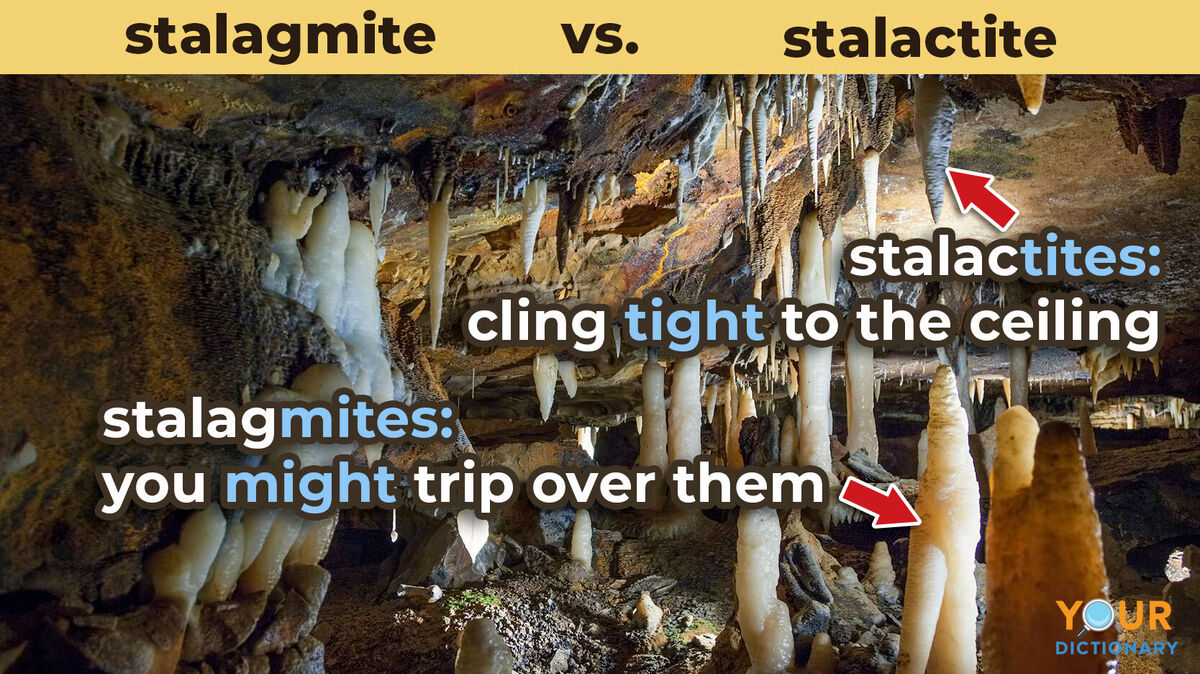
Whether you're a speleology enthusiast or simply enjoy visiting show caves, it's important to know the similarities and differences between stalagmites and stalactites. Discover some key facts about these fabulous cave formations and find out how to quickly and easily tell the difference.
Stalagmite vs. Stalactite Similarities
Stalagmites and stalactites are among the most common — and beautiful — formations found in caves. These two types of cave formations are similar in several ways.
- Stalagmites and stalactites are speleothems. This means that they are cave features formed via mineral deposits.
- For stalagmites and stalactites to form in a cave, water or another form of moisture must be able to get into the cave.
- Both form and grow as a result of dripping water (or other liquid) that picks up minerals as it travels through the cave structure.
- These formations grow very slowly. The average is 10 centimeters per thousand years, with the exact speed varying on climate and cave conditions.
- Both types of formations are very fragile. It is unlawful to break off or remove stalagmites, stalactites or any other cave formations.
- It's important to avoid touching these formations, as the natural oil on human skin can cause them to stop growing.
Stalagmite vs. Stalactite Differences
The primary difference between stalagmites and stalactites has to do with their direction of growth, though there is also some variation in shape.
- Stalagmites grow up from the ground, or floor, of the cave. Stalactites grow down from the top, or ceiling, of the cave.
- Stalagmites form mounds as they grow. Stalactites are shaped like icicles.
- Stalagmites tend to be thicker at the bottom than the top. Stalactites tend to be thicker at the top.
- Most stalagmites have rounded tips. Most stalactites have pointed tips.
Video Illustration
While it might not be feasible to go walk through a cave right now, a video is a great way to see these formations for yourself. Review this brief video taken in a cave in Australia. In just a little more than three minutes, you'll be able to view stalagmites and stalactites in their natural environment.
Easy Mnemonic Devices to Tell the Difference
The key to recognizing stalagmites and stalactites involves remembering which one grows up from the bottom of the cave and which one grows down from the top. Use these easy mnemonic devices to keep them straight in your mind.
Learn via Letter Association
The words stalagmite and stalactite have very similar spellings. Looking closely at these spelling differences provided a trip for remembering which grows from the top of the cave and which grows from the ground.
- Stalagmite has a "g" in the word. Remember that "g" stands for ground. Stalagmites grow up from the ground.
- Stalactite has one more "t" in it than the other word. Remember that "t" stands for top. Stalactites grow down from the top of the cave.
Helpful Homophone Rhyme
Remembering a cute saying using a cute homophone rhyme for the last syllable of each word provides a simple way to remember how these two types of cave formations differ.
- Stalagmites grow up from the floor, so you just might trip over them if you're not watching where you're going.
- Stalactites cling tight to the ceiling, so they hang down above your head.
When Stalagmites and Stalactites Meet
It's not unusual for a stalagmite and stalactite to grown directly above and below one another. When this happens, over time, the two formations can actually grow together and touch. They will fuse together to form a single spectacular formation called a column.

See Stalagmites and Stalactites for Yourself
Visiting a show cave that is open to the public is the best way to see stalagmites, stalactites and other kinds of cave formations for yourself. Luray Caverns in Virginia is one of the most popular tourist caves, but there are many others throughout the United States and in other parts of the world. The National Caves Association is a good resource for finding cave tours near where you live or places you plan to travel.
Discover Natural Resources
Caves are an amazing part of the natural world, but they're not the only ones. Now that you've learned about the difference between these two types of cave formations, make a point of learning more about the world around you. Start by getting to know examples of natural resources from around the world. From there, consider building your vocabulary with nature words. That way, you'll be better able to write about or discuss what you discover. You might also want to explore other commonly confused positioning words like prone vs. supine or latitude vs. longitude.